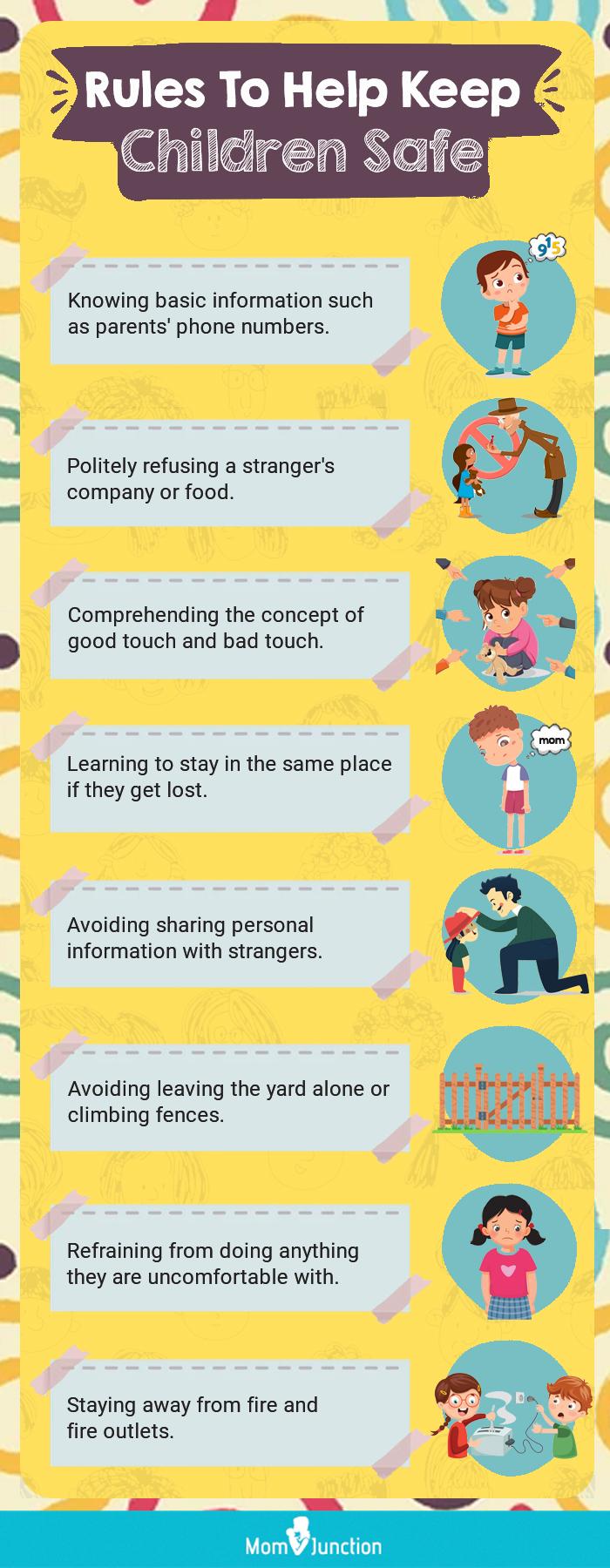10 General Safety Rules You Should Teach Your Children
You may be constantly concerned about your child’s safety, whether they are playing outside or within the house. Keeping your child safe at all times necessitates continual parental guidance. In such cases, establishing a few safety rules for children can be beneficial.
If you are not sure how to go about setting these rules, we’ve got you covered. Continue reading to learn about common safety principles for home and school that you can teach your child to ensure their safety.
Mục Lục
Top 10 General Safety Rules For Kids At School
As a parent, you may want to always be present near your kid. But this is not possible. You have to let your kid venture out without you. There are places where your kid will meet others in your absence, for example, at school. Your kid may also need to be at the day care or at home with a nanny. Also, it is important to prepare your kid for basic safety steps in the event of an emergency.
Here we list out 10 kids safety rules, that will help in ensuring safety at school and home:
1. Safety Rule #1 Know Your Name, Number And Address:
Your kid may be small but it is important to teach basic contact details like your and your partner’s name and contact number. Your kid should be able to share your contact number with someone in case of an emergency. Also, knowing where home is and any nearby landmark is also important. Help your kid memorize these with regular practice at home. Also, help your kid memorize a backup number to call, like a grandparent, uncle or aunt.

Quick fact
In America, a child goes missing or is kidnapped every 40 seconds (1)
2. Safety Rule #2 Do Not Eat Anything Given By A Stranger:
You need to teach your child about stranger danger i.e., the dangers of eating food given by a stranger. No matter how tempting the treat is, if it comes from a stranger, your kid should not eat it. Teach your kid that it is dangerous to accept food from anyone. Ask them to politely refuse in case someone is offering food without your consent or in your absence.
3. Safety Rule #3 Do Not Climb The Fence:
Your kid may be playing ball and suddenly it bounces off to a space inside a fence. Teach your kid never to try and retrieve something by climbing through a fence. If something like this happens, your kid should ask the help of a grown up, but never go near a fence.
4. Safety Rule #4 Do Not Walk Off The Yard Alone:
Similar to the point above, your kid should know about outdoor safety and that it is not permissible to walk out of your yard alone. If your kid needs to go out for anything, you or some known adult should be accompanying your kid at all times.
5. Safety Rule #5 Playing Or Experimenting With Fire Is Not Allowed:
Whether or not you are at home, your kid should know the concept of fire safety and that it is absolutely not allowed to play with fire. Only if you are around and have given your permission can your kid be near fire. Make sure all fire outlets are safely out of your kid’s reach.

Experts say
According to the U.S. Fire Department, children below five years are at a higher risk of dying in fires (2)
6. Safety Rule #6 Never Go Anywhere With A Stranger:
Your kid should know that no matter what the reasoning, it is not safe to go anywhere with a stranger. Tell your kid that if a stranger tells them something like ‘Your mom asked you to come with me immediately,’ they should stay where they are and shout out for help. Ensure that if there is an emergency, you will always send a family member, like a grandparent or aunt, to be with your kid and not a stranger.
7. Safety Rule #7 No One Is Allowed To Touch Your Kid’s Body:
This is a very important personal safety rule for kids and you should teach about it as soon as your kid can understand the basics. Teach about good touch and bad touch. Tell your kid that no one is allowed to touch your kid except mommy, and sometimes papa, if needed. If anyone else has touched your kid, your kid should immediately shout for help and alert people around.
8. Safety Rule #8 If You Get Lost, Stay Where You Are:
In the event that your kid gets lost, tell them it is important they stay right where they are. If they see any other mom with kids nearby, they can ask her for help. Your kid should stay inside the place and not go out, even with the other mom. Most common places where kids get lost are the super markets. Tell your kid that they can walk up to the counter of the store and tell the person they are lost.

Quick tip
When going in crowded places, proactively set a meeting place to reach if anyone gets separated (3)
9. Safety Rule #9 Do Not Share Address And Phone Details With Anyone (Except Emergency Situations As In Point 1):
Your kid should know that it is unsafe to share personal details like phone numbers, address, email ids or pictures with strangers. Any information that is shared should only be with your consent or in your presence.
10. Safety Rule #10 If I Am Uncomfortable I Will Not Do It:
No matter what your kid may be asked to do, if it makes your kid uncomfortable, your kid should NOT do it. This could be something as simple as taking off clothes in front of others and diving in a home pool. If your kid is not comfortable about it, no matter how many friends are doing it, your kid should not do it at all.
Frequently Asked Questions
1. Why is it important to teach safety rules to children?
Teaching children about safety helps them identify and respond to potential dangers and make safe choices in different situations. Additionally, it gives them the skills and knowledge they need to navigate challenging situations, which boosts their confidence and resilience.
2. What is meant by safety rules for children?
Safety rules are guidelines that save and protect children from any harm. Additionally, they equip children with the knowledge and skills needed to respond appropriately to challenging situations.
3. At what age should I teach safety rules to my child?
Usually, children can begin learning safety rules from around two to three years of age. However, this may vary from one child to another depending on their development and ability to understand the instructions. Nevertheless, it’s vital to teach children about safety early on and continually reinforce these lessons as they grow.
In addition to this, age-appropriate knowledge about traffic safety, water safety, food safety, cyber safety, electrical safety, and poison safety can help children protect themselves if confronted with unsafe situations. Familiarizing them with sun safety and bike safety can help them fearlessly navigate the outdoors. Emergency preparedness with adequate first aid training can help your child face and overcome adverse situations. Talking to your child about basic self-defense skills will enable them to defend themselves and build confidence.
These general safety rules for children must be included in the lessons you teach them. Although it may be difficult for them to understand the gravity of these rules, approaching them calmly and setting out illustrative scenarios may help. Despite these safety rules for children, remember to be vigilant and always communicate openly to help them open up and reach out to you.
Infographic: General Safety Rules For Children
Ensure your child’s safety by teaching them general safety rules, including being aware of their surroundings, knowing things to avoid, and learning basic contact information. Remember to reinforce these rules to protect your child consistently. Here is an infographic detailing what to teach your child. Read on! Save
Save
Get high-quality PDF version by clicking below.

Key Pointers
- Teach children home safety rules, such as not playing with electrical outlets or fire.
- Children should learn outdoor safety guidelines, including wearing protective gear when bicycling and checking both ways before crossing the street.
- Teach children personal safety rules, such as responding to emergencies like fires and avoiding sharing personal information with strangers.
- Children should also learn internet safety rules, such as not sharing personal information and avoiding conversations with unknown people online.
References:
MomJunction’s articles are written after analyzing the research works of expert authors and institutions. Our references consist of resources established by authorities in their respective fields. You can learn more about the authenticity of the information we present in our editorial policy
- Runaways and Missing Kids; Illinois Department of Children & Family Services
https://www2.illinois.gov/dcfs/safekids/missing/Pages/default.aspx - Child Fire Death Risk; U.S. Fire Administration
https://www.usfa.fema.gov/statistics/deaths-injuries/children.html - Some Basic Things to Teach Your Child to Do if They Get Lost; Lost Child Education; Brighton Colorado
https://www.brightonco.gov/DocumentCenter/View/11299/Lost-Child-Education?bidId= - Protecting our kids: Teaching children about personal safety
https://bravehearts.org.au/protecting-our-kids-teaching-children-about-personal-safety/
Was this article helpful?
The following two tabs change content below.
- Reviewer
- Author
![]()
Beth Sullivan
Beth Sullivan is an education consultant and president of Deep Roots Learning Solutions, Inc. She specializes in literacy instruction and works primarily with students learning challenges, including dyslexia, ADHD and autism. After working in schools as a special educator for ten years, Beth has shifted her focus to supporting individual students and their families through online tutoring. She also provides… more
![]()
Mitha Shameer
Mitha is passionate about writing on topics related to women and children. She loves to present the brighter side of life to her readers in the form of her articles. With more than two years of experience, she writes on games, stories, arts & craft, celebrations and more for MomJunction. When she isn’t glued to online shopping websites, she loves… more
















![Toni Kroos là ai? [ sự thật về tiểu sử đầy đủ Toni Kroos ]](https://evbn.org/wp-content/uploads/New-Project-6635-1671934592.jpg)


